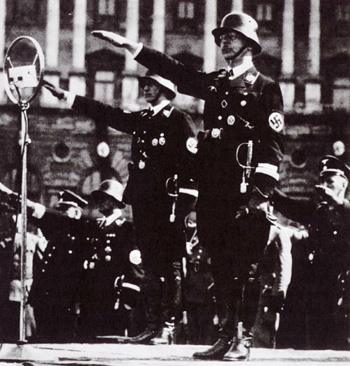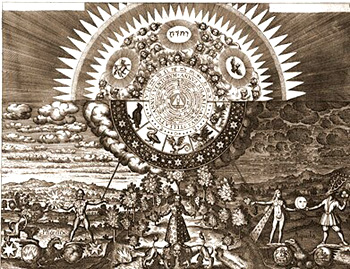 |
Secret Forces
Nazism, a Gnostic-Manichean Sect - Part I
Pagan & Christian Gnosis
Cunha Alvarenga
In 1931 and 1937 Alfred Rosenberg, the theoretician of Nazism who had such a great influence over Adolph Hitler, ordered the scholar Otto Rahn to make a careful study of the ruins of the Castle of Montségur, the citadel and temple of the Cathars. This castle was the last refuge for the Cathar heresy that contaminated Southern France in the 11th and 12th centuries.

Himmler, head of the occult SS elite troops |
At about the same time, Heinrich Himmler, the supreme commander of the SS, reconstructed the Castle of Wewelsburg, near Paderborn in Westphalia, Germany. In its gothic basement, he placed a black marble altar emblazoned with the silver letters SS. This altar was meant to hold the object that the heads of Nazism were expecting Otto Rahn to find at Montségur: the mysterious Grail and an ancient stone book that contained the compendium of the Gnostic tradition. In this sinister chapel, the SS, elite troops of the National Socialists, would meditate on the the book of Otto Rahn, Lucifer’s Court in Europe.
These strange facts reveal that, different from what the general public thinks, Hitlerism was not above all a political movement.
Actually, when one studies National Socialism from the perspective of old esoteric doctrines, he finds himself before a true religious sect of the Gnostic-Manichean bent, whose origins are linked to Cathar strongholds in medieval castles of Southern France. Hitler, Hess, Himmler, Rosenberg and other highly placed public figures of Nazism would have been initiated in an esoteric religion that had its hierarchy, temples, rites and dogmas.
Gnosis, a live spark in the ashes
Gnosis is the pantheistic foundation of almost all the great heresies that have scourged Christendom since the apostolic times. It is the live spark in the ashes, so to speak, that lies amidst the errors repudiated by the Catholic Truth. As cold and dead as the ashes may appear to be, the spark always reignites in new fires to generate incredible new devastations.
Throughout the centuries, gnosis has taken on different appearances. There are entire Gnostic systems wearing different disguises in the heresies of the first centuries of the Church. Generally speaking, we can distinguish a pagan gnosis and a so-called Christian gnosis. The origin of the pagan gnosis is lost in the dark night of time. All the Ancient World was plunged into it.

The quest for Gnosis (knowledge) in all of creation, according to esoteric alchemy |
The Manichean Gnostics, for example, sustain that gnosis existed even before the Deluge in Atlantis, Lemuria, and Hiperborea, civilizations that would have existed before that terrible chastisement. Remaining within the boundaries of documented history, before Christ we find pagan gnosis in Persia, India, and Greece, among other peoples.
After the coming of Our Redeemer, one encounters the expression Christian gnosis, an inappropriate designation, given that the various Gnostic heresies were only attempts to disguise the old pagan error in Catholic apparel. The Christian gnosis pretends that there is an opposition between spirit (the principle of good) and matter (the principle of evil). The former was linked to the latter as a consequence of a cosmic disaster. This is the opposite of Catholic doctrine, which teaches us that creation itself is good in both spiritual and material beings.
Gnosis is evolutionist and longs for the time when, after successive mutations, the spirit will once again be freed from the chains that imprison it to matter. Gnosis is pantheist, because it confuses divinity with this spirit enslaved to matter. The Gnostics deny the dogma of God as Creator, because they confuse the Creator with the creature. They also reject the dogma of the Holy Trinity and the Incarnation of the Divine Word in the flesh of a man, since they deny the dogma of the hypostatic union. In the internal logic of their monstrous error, the Gnostics also repudiate the Most Holy Virgin as the Mother of God, a truth proclaimed at the Nicaean Creed, which condemned the Gnostics of the time and their esoteric tendencies. Indeed, this heresy has always been known for its secret, magic and occult practices, which at times leads it to a black magic and at other times to a white magic.
Political and social consequences
From the times of the Apostles onward, this ensemble of errors has had political and social consequences. It is expressive that among the first Gnostic heretics in the ranks of Holy Mother Church, a group led by Simon the Magician called the Ebonites preached complete poverty, not as an evangelical counsel, but as an imperative precept. This practical negation of the right to private property led them to a total egalitarianism and an early form of Communism. In their horror for matter, they justified ritual suicide. They also opposed the Sacrament of Matrimony because it sanctifies the birth of new beings, which, according to them, would be continuing that first evil mistake of uniting spirit to matter.
Continued

Posted February 20, 2008
Translated from Catolicismo, September 1971
History | Home | Books | CDs | Search | Contact Us | Donate

© 2002-
Tradition in Action, Inc. All Rights Reserved
|
 |

|
|